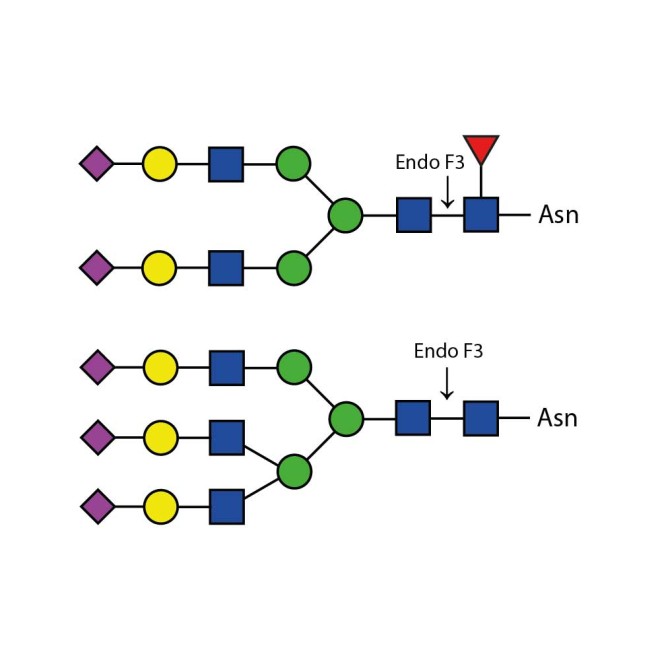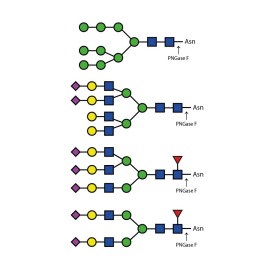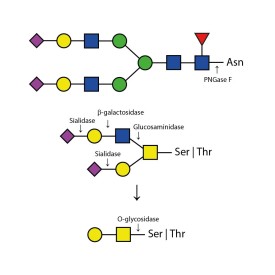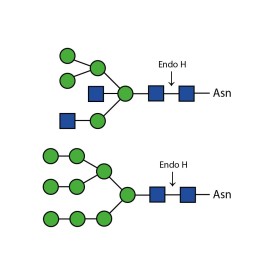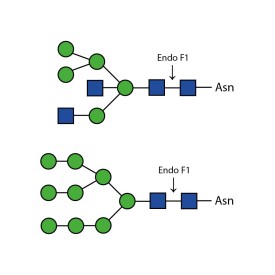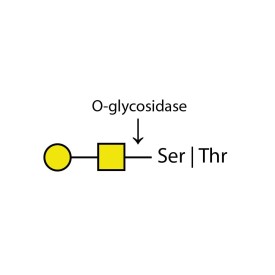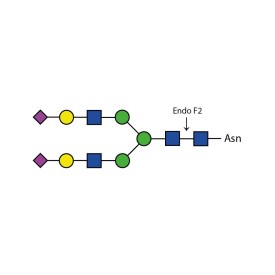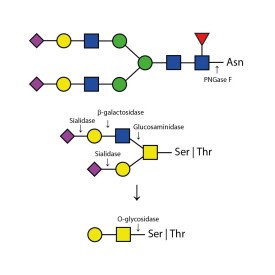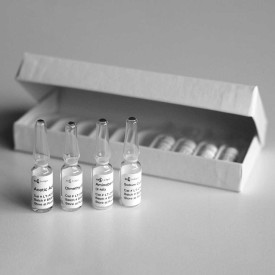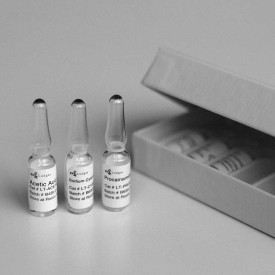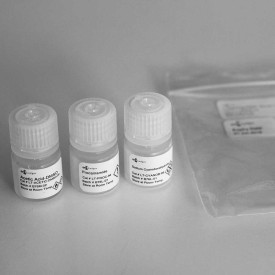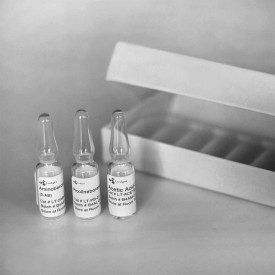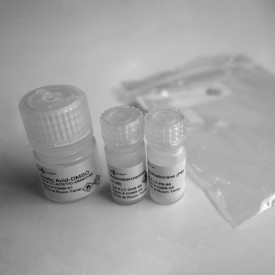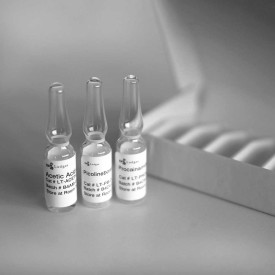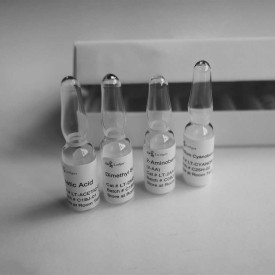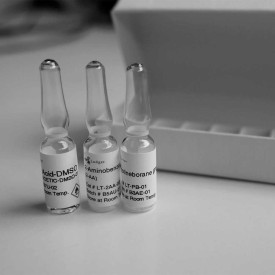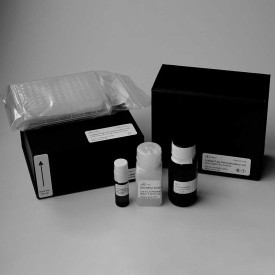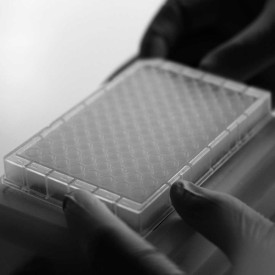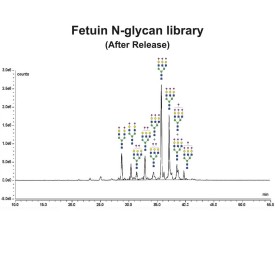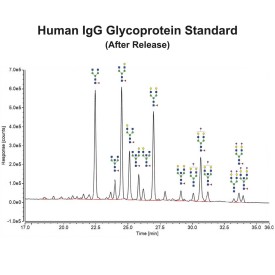Endoglycosidase F3
References:
1. Maley P., R. B. Trimble, A. L. Tarentino and T. H. Plummer Jr. Characterization of glycoproteins and their associated oligosaccharides through the use of endoglycosidases. Anal Biochem 180:195-204 (1989).
2. Plummer, T. H. Jr, A. W. Phelan and A. L. Tarentino. Porcine fibrinogen glycopeptides: substrates for detecting endo-N-acetylglucosaminidases F2 and F3. Anal Biochem 235:98-101 (1996).
3. Reddy A., B. G. Grimwood, T. H. Plummer Jr and A. L. Tarentino. High- level expression of the Endo-beta-N- acetylglucosaminidase F2 gene in E.coli: one step purification to homogeneity. Glycobiology 8:633-636 (1998).
4. Tarentino, A. L., C. M. Gomez and T. H. Plummer Jr. Deglycosylation of Asparagine-Linked Glycans by Peptide:N-Glycosidase F. Biochemistry 24:4665-4671 (1985).
5. Tarentino A. L., G. Quinones, W. P. Schrader, L. M. Changchien and T. H. Plummer Jr. Multiple endoglycosidase (Endo) F activities expressed by Flavobacterium meningosepticum. Endo F1: molecular cloning, primary sequence, and structural relationship to Endo H. J Biol Chem 267:3868-3872 (1992).
6. Tarentino A. L., G. Quinones, L. M. Changchien, and T. H. Plummer Jr. Multiple endoglycosidase F activities expressed by Flavobacterium meningosepticum endoglycosidases F2 and F3: Molecular cloning, primary sequence, and enzyme expression. J Biol Chem 268(13):9702-9708 (1993).
7. Tarentino A. L. and T. H. Plummer Jr. Substrate specificity of Flavobacterium meningosepticum: Endo F2 and endo F3: purity is the name of the game. Glycobiology 4:771-773 (1994).
8. Tarentino, A. L. and T. H. Plummer Jr. Enzymatic deglycosylation of asparagine- linked glycans: purification, properties and specificity of oligosaccharide- cleaving enzymes from Flavobacterium meningosepticum. Methods in Enzymology 230:44-57 (1994).
9. Tarentino A. L., G. Quinones and T. H. Plummer Jr. Overexpression and purification of non-glycosylated recombinant endo-beta-N- acetylglucosaminidase F3. Glycobiology 5:599-601 (1995).
10. Trimble, R. B. and A. L. Tarentino. Identification of Distinct Endoglycosidase (Endo) Activities in Flavobacterium meningosepticum: Endo F1, Endo F2 and Endo F3. J. Biol Chem 266:1646-1651 (1991).
Selective release of triantennarry and α(1-6) fucosylated biantennary N-glycans from peptides and protein.
Endo F3 cleaves free or Asparagine-linked triantennary or α(1-6) fucosylated biantennary oligosaccharides,as well as triamnnosyl chitobiose core structures. Nonfucosylated biantennary glycans will also be cleaved, but at a 40x reduced rate. It cleaves between the two N-acetylglucosamine residues in the diacetylchitobiose core of the oligosaccharide, generating a truncated sugar molecule with one N-acetylglucosamine residue remaining on the asparagine. In contrast, PNGase F removes the oligosaccharide intact. α(1-3) fucosylation will inhibit enzymatic activity. There is no activity on oligomannose and hybrid molecules.
Kit includes enzyme plus reaction buffer. Sufficient for up to 60 reactions.
Product Specification
Source: Recombinant Elizabethkingia miricola in E. Coli
EC: 3.2.1.96
Alternative Names: Endo F3, Endoglycosidase F3, endo-β-N-acetylglucosaminidase F
Specificity:
Cleaves all asparagine-linked triantennary or α(1-6) fucosylated biantennary oligosaccharides, as well as triamannosyl chitobiose core structures. α(1-3) fucosylation will inhibit enzymatic activity. Nonfucosylated biantennary glycans will also be cleaved, but at a 40x reduced rate. (Note: The recombinant version is not glycosylated, which may result in properties differing from the native protein.)
Contents:
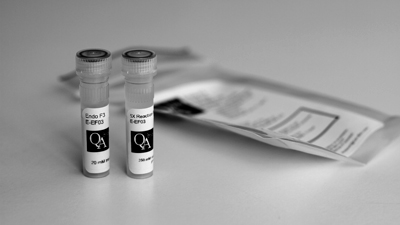
60 µL aliquot of enzyme (0.3 U) in 20 mM Tris-HCl, pH 7.5
5x Reaction Buffer - 250 mM sodium acetate, pH 4.5
Specific Activity: >25 U/mg
Activity: >5 U/mL
Molecular weight: 30,000 daltons
Suggested usage:
1. Add up to 200 µg of glycoprotein to an Eppendorf tube. Adjust to 38 µL final volume with de-ionized water.
2. Add 10 µL 5x Reaction Buffer 4.5
4. Add 2.0 µL of Endo F3. Incubate 1 hour at 37°C.
Specific Activity:
Defined as the amount of enzyme required to catalyze the release of N-linked oligosaccharides from 1 micromole of porcine fibrinogen in 1 minute at 37°C, pH 4.5. Cleavage is monitored by SDS-PAGE (cleaved fibrinogen migrates faster).
Storage: Store enzyme at 4°C.
Stability: Stable at least 12 months when stored properly. Several days exposure to ambient tempertures will not reduce activity.
Purity: Endoglycosidase F3 is tested for contaminating protease as follows; 10 µg of denatured BSA is incubated for 24 hours at 37°C with 2 µL of enzyme. SDS-PAGE analysis of the treated BSA shows no evidence of degradation.
The production host strain has been extensively tested and does not produce any detectable glycosidases.


